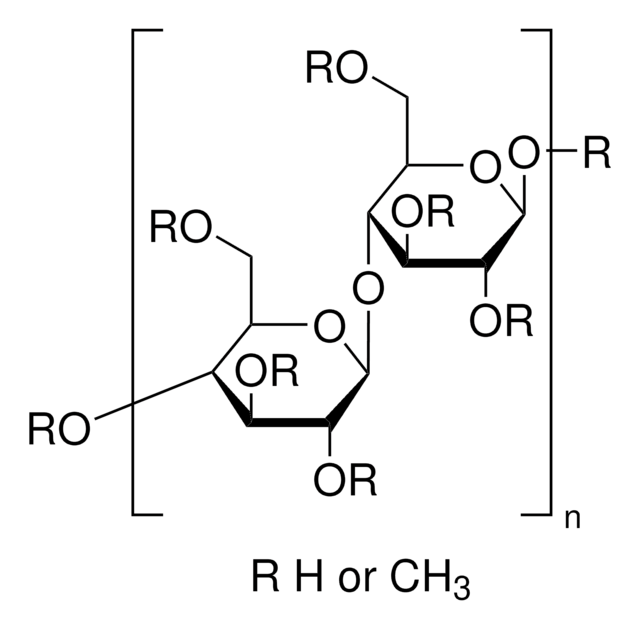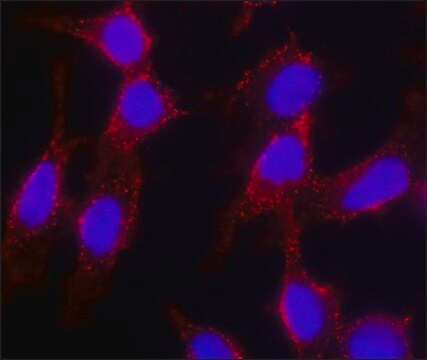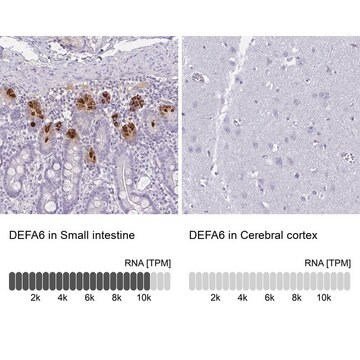HTS005M
ChemiSCREEN CCR1 Membrane Preparation
Human CCR1 GPCR membrane preparation for Radioligand binding Assays.
Faça loginpara ver os preços organizacionais e de contrato
About This Item
Código UNSPSC:
41106514
eCl@ss:
32161000
NACRES:
NA.84
Produtos recomendados
fonte biológica
human
Nível de qualidade
recombinante
expressed in Chem-2 cells
fabricante/nome comercial
ChemiScreen
Chemicon®
concentração
0.5 mg/mL
técnica(s)
radioligand binding assay (RLBA): suitable
nº de adesão NCBI
nº de adesão UniProt
Condições de expedição
dry ice
Informações sobre genes
human ... CCR1(1230)
Descrição geral
CCR1 is a GPCR that binds to a variety of CC ligands, including MIP-1a, RANTES, MCP-3, HCC-1, HCC-2, HCC-4, and MPIF-1 (Olson and Ley, 2002). Lymphocytes, macrophages, dendritic cells, and GM-CSF-activated neutrophils express CCR1 (Kaufmann et al., 2001; Cheng et al., 2001). Two selective, non-peptide small molecule antagonists of CCR1, BX-471 and CP-481,715, have been synthesized (Gladue et al., 2003; Liang et al., 2000). Pharmacological and genetic targeting of CCR1, either alone or in combination with cyclosporin A, reduces cardiac and renal allograft rejection (Gao et al., 2000; Horuk et al., 2001a; Horuk et al., 2001b), allergic encephalomyelitis (Liang et al., 2000), and renal fibrosis (Anders et al., 2002) in experimental models. Chemicon′s CCR1 Membrane Preparations are ideal for screening molecules that disrupt interaction between CCR1 and its ligands. The CCR1 Membrane Preps bind to MIP-1a with a Kd of 1.8 nM, and yield greater than 10-fold signal to background ratio with a MIP-1a concentration of 0.1 nM.
Full-length human CCR1 cDNA
Aplicação
Radioligand binding assay.
Ações bioquímicas/fisiológicas
GPCR Class: A
Protein Target: CCR1
Target Sub-Family: Chemokine
Qualidade
SPECIFICATIONS:
Bmax for [125I]MIP-1alpha binding: 3.3 pmol/mg protein
Kd for [125I] MIP-1alpha binding: ~ 1.8 nM HOST CELLS:
Bmax for [125I]MIP-1alpha binding: 3.3 pmol/mg protein
Kd for [125I] MIP-1alpha binding: ~ 1.8 nM HOST CELLS:
forma física
Liquid in packaging buffer: 50 mM Tris pH 7.4, 10% glycerol and 1% BSA with no preservatives.
Packaging method: Membranes protein were adjusted to the indicated concentration in packaging buffer, rapidly frozen, and stored at -80°C.
Each vial typically contains 500 units, where one unit is the amount of membrane prep that yields greater than 1000 cpm specific binding of 125I-labeled MIP-1α (0.1 nM input concentration).
Packaging method: Membranes protein were adjusted to the indicated concentration in packaging buffer, rapidly frozen, and stored at -80°C.
Each vial typically contains 500 units, where one unit is the amount of membrane prep that yields greater than 1000 cpm specific binding of 125I-labeled MIP-1α (0.1 nM input concentration).
Armazenamento e estabilidade
Maintain frozen at -70°C for up to 2 years. Do not freeze and thaw.
Informações legais
CHEMICON is a registered trademark of Merck KGaA, Darmstadt, Germany
Exoneração de responsabilidade
Unless otherwise stated in our catalog or other company documentation accompanying the product(s), our products are intended for research use only and are not to be used for any other purpose, which includes but is not limited to, unauthorized commercial uses, in vitro diagnostic uses, ex vivo or in vivo therapeutic uses or any type of consumption or application to humans or animals.
Código de classe de armazenamento
12 - Non Combustible Liquids
Classe de risco de água (WGK)
WGK 2
Ponto de fulgor (°F)
Not applicable
Ponto de fulgor (°C)
Not applicable
Certificados de análise (COA)
Busque Certificados de análise (COA) digitando o Número do Lote do produto. Os números de lote e remessa podem ser encontrados no rótulo de um produto após a palavra “Lot” ou “Batch”.
Já possui este produto?
Encontre a documentação dos produtos que você adquiriu recentemente na biblioteca de documentos.
S S Cheng et al.
Journal of immunology (Baltimore, Md. : 1950), 166(2), 1178-1184 (2001-01-06)
Neutrophils (polymorphonuclear leukocytes; PMN) are phagocytic cells instrumental in the clearance of infectious pathogens. Human PMN are commonly thought to respond primarily to chemokines from the CXC family. However, recent findings suggest that under specific cytokine activation conditions, PMN can
Nossa equipe de cientistas tem experiência em todas as áreas de pesquisa, incluindo Life Sciences, ciência de materiais, síntese química, cromatografia, química analítica e muitas outras.
Entre em contato com a assistência técnica






